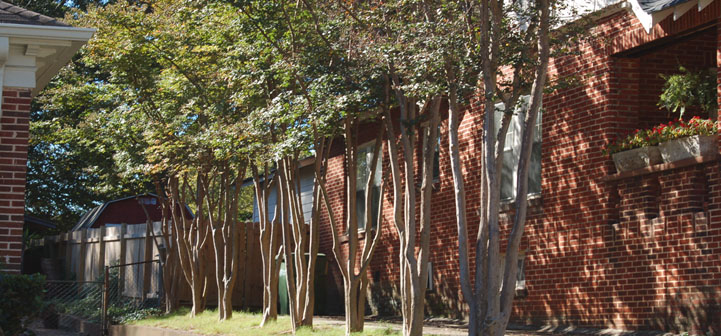It is possible to plant a tree that within a few years will provide energy conservation benefits. The length of time between planting and energy conservation savings is a function of the following factors:
- Tree species (fast- or slow-growing)
- Site (soil qualities such as fertility, moisture, compaction)
- Desired energy conservation function (windbreak or shade)
- Size and position of the structure for which energy conservation is desired
Some fast-growing tree species, under ideal growing conditions, may begin providing energy benefits (deflecting winds or casting shade) in as few as 5 years. In other cases, slower-growing species good for long-term energy conservation may take 20 years or more to begin providing benefits.
 |
| Photo Credit: Raina Sheridan |
In general, the faster growing the species, the shorter the lifespan. Hybrid Poplar, for example, is a sterile cross between two Poplus species such as Cottonwood (Populus deltoides) and Black Poplar (Populus nigra). This is a very fast-growing tree that on good soils grows an average of 4 – 6 feet a year (Demeritt, 1981), but may have a typical lifespan of only 10 years before succumbing to disease.
Fast-growing trees such as this could be used to gain more immediate energy conservation benefits, but should be considered temporary plantings. At the same time as planting the fast-growing species, longer-lived species should also be planted in position to take the place of these temporary trees.
Species is not everything. The growth rate of any tree is directly related to the overall condition of the site. Ideal soil conditions (optimum fertility, moisture and drainage) will maximize growth rates. While this is true for all trees, some are more sensitive than others to site limitations. For example, red maple (Acer rubrum) is one of the most common species in the United States, partly because it tolerates such a wide variety of sites. Black walnut (Juglans nigra) can be a fast-growing tree when planted on deep, well-drained soils such as a floodplain. If planted on shallow soils, it may survive but grow slowly for many years.
Additionally, young trees tend to be very vigorous growers. As an example, oak trees tend to have a moderate growth rate, but as young, newly planted trees, they can quickly grow in height and width on favorable sites.
Finally, factors such as the size of the structure for which energy conservation is desired, its position within the landscape, and the conservation function wanted may influence how long a tree needs to grow to begin providing energy benefits. Smaller structures, such as a small house or shop, can begin to receive cooling shade from a tree that is only 10-20 feet high. If this same house is downhill from the trees casting shade, the benefits will be even sooner. Likewise, if windbreaks are desired, there are many fast-growing species that may be able to obtain functional heights in just a few years, even sooner if the topography of the planting area is higher than the structure.
For the most part, conservation benefits from trees increase with time, as the tree or trees grow in height and spread. Trees, however, have a limited life span and obviously stop providing energy benefits when they die. As trees approach over-maturity, energy benefits are maximized, but risk of tree/branch failure is also increased.
When it comes to reaping energy conservation benefits from strategically placed trees around your home, barn, or business, time is money, but don’t forgo future benefits at the cost of procrastination. Whether the structure you desire to shelter from wind and/or sun is one that you think you’ll “live in” for a long time or not, the time to plant a tree is now.
We have made at least a start at discovering the meaning of human life when we plant shade trees under which we know full well we will never sit. –– Elton Trueblood, Quaker philosopher
The planting of trees shows faith in the future. — Charles Schultz
Planting a tree is among the most noble and selfless acts one can do. In many cases, a tree planter will not reap but a portion of the forthcoming energy conservation returns, but he or she does reap all of the satisfaction of having planted a tree that may outlive the individual.
Also see
- Tree Planting for Lower Power Bills – eXtension
- Which trees are recommended for maximum energy conservation …
- Where can I find information about trees I can plant for energy …
- Choosing the Best Landscape Trees for Home Energy Conservation …
- Energy Conservation through Tree Planting: Tips for Renters …
Citation:
Demeritt, Maurice E., Jr. 1981. Growth of hybrid poplars in Pennsylvania and Maryland clonal tests. USDA Forest Service, Research Note NE-302. Northeastern Forest Experiment Station, Bromall, PA. 2 p.
By: Adam Downing, Forestry and Natural Resources Extension Agent, Virginia Tech University
